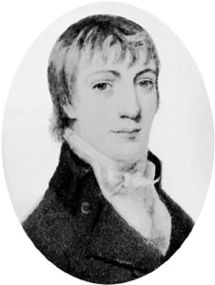Robert Bloomfield
| Robert Bloomfield | |
|---|---|
 |
|
| Born | 3 December 1766 Honington, Suffolk |
| Died |
19 August 1823 (aged 56) Shefford, Bedfordshire |
| Occupation | shoemaker, bookseller |
| Genre | rustic descriptive verse |
| Notable works |
The Farmer's Boy (1800) Rural Tales, Ballads and Songs (1802) |
Robert Bloomfield (3 December 1766 – 19 August 1823) was an English labouring class poet whose work is appreciated in the context of other self-educated writers such as Stephen Duck, Mary Collier and John Clare.
Robert Bloomfield was born of a poor family in the village of Honington, Suffolk. His father was a tailor and died of smallpox when his son was a year old. It was from his mother Elizabeth, who kept the village school, that he received the rudiments of education. Apprenticed at the age of eleven to his mother's brother-in-law, he worked on a farm which was part of the estate of the Duke of Grafton, his future patron. Four years later, owing to his small and weak stature (in adulthood Bloomfield was just five feet tall) he was sent to London to work as a shoemaker under his elder brother George. One of his early duties was to read the papers aloud while the others in the workshop were working and he became particularly interested in the poetry section of The London Magazine. He had his first poem, "The Village Girl", published in 1786. When his brother George returned to Suffolk in that year, he set up on his own as a cobbler and in 1790 married Mary Ann Church, by whom he was to have five children.
The poem that made his reputation, The Farmer's Boy, was composed in a garret in Bell Alley,Coleman Street. It was influenced by James Thomson's poem The Seasons. Bloomfield was able to carry some fifty to a hundred finished lines of it in his head at a time until there was opportunity to write them down. The manuscript was declined by several publishers and was eventually shown by his brother George to Capel Lofft, a radical Suffolk squire of literary tastes, who arranged for its publication with woodcuts by Thomas Bewick in 1800. The success of the poem was remarkable, over 25,000 copies being sold in the next two years. Also reprinted in several American editions, it appeared in German translation in Leipzig, translated into French as Le Valet du Fermier in Paris, and in Italian translation in Milan; there was even a Latin translation of parts of it, De Agricolae Puero, Anglicano Poemate celeberrimo excerptum, et in morem Latini Georgice redditum, by the lively Suffolk vicar William Clubbe. The poem was particularly admired by the Suffolk-born painter John Constable who used couplets from it as tags to two paintings: a 'Ploughing Scene' (shown at the Royal Academy in 1814) and 'A Harvest Field, Reapers, Gleaners' (shown at the British Institution in 1817), which he noted as deriving from 'Bloomfield's poem'. It was also admired by Robert Southey, a Romantic poet and future poet laureate.
...
Wikipedia
